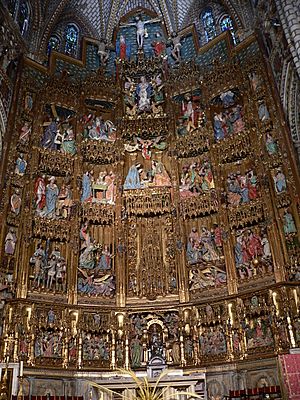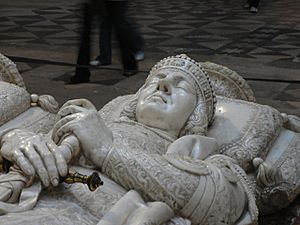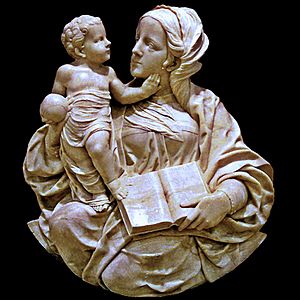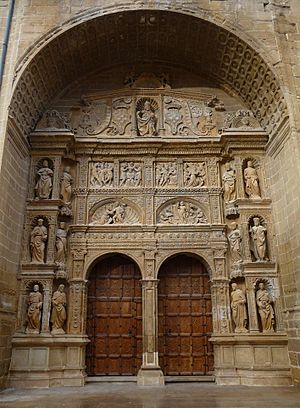Felipe Bigarny facts for kids
Felipe Bigarny (born around 1475 – died November 10, 1542) was a famous sculptor. He was also known as Felipe Vigarny or Felipe de Borgoña. People sometimes called him El Borgoñón (the Burgundian). He was born in Burgundy, France. But he became very successful in Spain. He was one of the most important sculptors of the Spanish Renaissance. He also worked as an architect.
His art showed influences from Flemish, Burgundian, and Italian Renaissance styles. He became very well-known across Spain. This led him to become the main sculptor for the Burgos Cathedral. He also created many important artworks for the Crown of Castile. He ran several art studios at the same time. Because of this, he became quite rich.
Contents
Biography
Early Life and Training
Felipe Bigarny was born in Langres, Burgundy, around 1475. When he was young, he went to Italy. It seems he studied art in Rome. This is why his early sculptures show Italian Renaissance influences. Even his early Gothic works have this touch.
His Career in Spain
In 1498, when he was about 23, Bigarny traveled to Santiago de Compostela. This was a famous pilgrim route. He decided to stay in Burgos, Spain. There, he created detailed sculptures for the main retrochoir of the cathedral. These works were very precise. They helped him get more jobs. This started his long career in Spain. He worked in all kinds of sculpture. He made both statues and decorations. He used both stone and wood.

In 1499, Bigarny designed the main altarpiece for the Toledo Cathedral. Cardinal Archbishop Francisco Jiménez de Cisneros hired him for this. He also made a statue of Saint Mark the Evangelist. He agreed to sculpt several reliefs for the altarpiece. He worked on these until 1504. Around the same time, he sculpted figures of Saints Augustine, Barbara, Gregory, Jerome, John the Baptist, and a scene of the Assumption. These were for the altarpiece of the University of Salamanca.
Next, he planned the chapel of the Sanctuary of the Palencia Cathedral. He made it clear that others in his studio would do most of the work. But he would personally sculpt the faces and hands. On December 12, 1506, Bigarny delivered seventeen sculptures. One was a polychromed (painted) Saint Antoninus of Pamiers. This saint was important to the cathedral. On October 19, 1509, he delivered nine more figures. All these were put together on the main altarpiece of that cathedral. In 1509, he went back to Burgos. He worked with Andrés de Nájera on the choir stalls of the Burgos Cathedral. This project finished in 1512. The panels on the top row of side chairs are thought to be by him and his workshop.
In 1513, he designed the baldachin (a canopy) for the tomb of Dominic de la Calzada. This was for the Cathedral of Santo Domingo de la Calzada in Santo Domingo de la Calzada, La Rioja. Juan de Rasines built his design.
In 1516, he started work on the main entrance and altarpiece of the Church of Saint Thomas in Haro, La Rioja. This was finished in 1519. That year, he also lived in Casalarreina, La Rioja, for a while. He might have helped build the La Piedad Monastery there. However, there are no records to prove this.
Around this time, he also made a side-view sculpture of Cardinal Cisneros. You can see it now at the Complutense University of Madrid. Records also show he made a similar sculpture of Antonio de Nebrija.
Bigarny married María Sáez Pardo. She was a widow with sons who had moved to the Americas. They had five more children together. Their first child, Gregorio Pardo, born in 1517, was the only one to follow his father's career. Gregorio worked with his father later in life. He continued Bigarny's studio in the Archdiocese of Toledo. Bigarny's style influenced many sculptures in Burgos. It also spread throughout Castile in the early 1500s. His influence was even stronger by the middle of the century. This lasted until a new style called Romanism became popular.
In 1519, he worked with Alonso Berruguete. They made the tomb of Cardinal Juan Selvagio in Zaragoza. The two artists likely continued working together on the Royal Chapel of Granada. Bigarny seems to have helped design it in 1521. But he was not directly involved in building it.
Working with Diego de Siloé
When Bigarny returned to Burgos, he started working with Diego de Siloé. Siloé had come back in 1519 after studying in Italy. Bigarny and Siloé were strong rivals. But Siloé was often seen as the more advanced artist. In 1523, they both created the Saint Peter altarpiece. This was in the Chapel of the Constables in the Burgos Cathedral. In the same chapel, between 1523 and 1526, they made figures for the main altarpiece. These showed the Presentation of Jesus at the Temple. This work is considered one of the most beautiful of the Spanish Renaissance. By 1534, Bigarny had also made the reclining sculptures in the chapel of Pedro Fernández de Velasco, 2nd Count of Haro and his wife.
Bigarny knew he was famous in Burgos. So, he made Burgos his permanent home. He first lived in the San Juan neighborhood. Later, he moved to a grand house near the Casa de la Moneda (Mint). In 1524, he took on a job to work on the tomb of the priest Gonzalo Díez de Lerma. This was also in the Burgos Cathedral, in the Chapel of the Presentation. This very expressive sculpture shows influences from Diego de Siloé.
There are no official records, but it is believed he completed the altarpiece of Santiago de la Puebla (in the province of Salamanca) around this time. He also likely made the sculptures of the Virgen de la Silla (Virgin Mary with Christ child and young John the Baptist) and the Virgin and Child. These were for the Church of the Assumption in El Barco de Ávila. The Virgin and Child is shown at the start of this article. It is now in the National Sculpture Museum in Valladolid. Other artworks also seem to be by Bigarny. These include the tomb of priest Diego Bilbao and an altarpiece in the church of Cardeñuela Riopico.
In 1526, a book called Medidas del Romano by Diego de Sagredo praised Bigarny's sculptures. This was one of the first Spanish books about architecture. Because of this praise, Bigarny received jobs from all over Spain.
In 1527, he finished the altarpiece of the Descent or of the Pillar in the Toledo Cathedral. He had probably started it in 1520. This work was also much influenced by Siloé. However, their working relationship soon ended. They disagreed about a contract to build the tower of the Church of the Assumption of Our Lady in Santa María del Campo. This led to Siloé successfully suing Bigarny.
Later Years and Legacy
In 1530, Bigarny gave his opinion on the work for the Salamanca Cathedral. Between 1531 and 1533, he sculpted the tomb of Bishop Alonso de Burgos. This was for the chapel of the Colegio de San Gregorio in Valladolid. This place is now the National Museum of Sculpture. This tomb was highly praised at the time. But looking back, it is not considered one of his best works. In 1534, he sculpted the tomb of Pedro Manso, bishop of Osma. This was for the Monastery of San Salvador de Oña.
When his wife María died, he quickly remarried in 1535 to Francisca Velasco.
In 1535, the Toledo Cathedral asked Bigarny, Diego de Siloe, Juan Picardo, and Alonso Berruguete for designs for the cathedral's choir stalls. On January 1, 1539, they hired Bigarny and Berruguete. Each was to create thirty choir stalls. Bigarny made those along the side of the Evangelist. He also worked on the Archbishop's side.
In 1536, he signed a contract. It said he would make two tombs within two years. One was for Diego de Avellaneda, Bishop of Tuy. It was for the Monastery of Saint Jerome in Espeja (province of Soria). The other was for his father. This tomb is now in Alcalá de Henares. However, by 1539, these were still not built. This was because he had taken on other projects. These round sculptures were given to Enrique de Maestrique to make. They were among the works left unfinished when Bigarny died. Juan de Gómez finished them. The Spanish government bought the tomb of Diego de Avellaneda in 1932. It is now in the National Sculpture Museum.
In 1541, he agreed to make an altarpiece for the Hospital of Santa Cruz in Toledo. This is now a museum. But it was never made. He died in 1542. He left behind many planned or unfinished works. These were in Toledo (where Berruguete continued his work), Peñaranda de Duero, Valpuesta, and Burgos. He had studios in all these places. Each studio had trusted people in charge when he was away. These included Maese Enrique, Sebastián de Salinas, Juan de Goyaz, his son Gregorio Pardo, and especially Diego Guillén. Guillén was married to one of Bigarny's sisters-in-law.
Family Life
With María Sáez Pardo, he had five children. These included the sculptor Gregorio Pardo. Another child was Clara, who was known for her beauty in Burgos. People called her "la niña de plata" ("the silver girl"). With Francisca Velasco, he had five more children.
Major Works
Most of Bigarny's artworks are in Burgos. He lived there for a long time. Many are also in Toledo, where he had his most important studio.
Sculptures
Bigarny mainly worked as a sculptor. He became most famous for his sculptures during his lifetime.
Burgos Cathedral

The Road to Calvary Relief
Bigarny's first work in Burgos was a large sculpture for the cathedral. It showed the Road to Calvary. This was used to decorate the central wall of the retrochoir. He started this work in 1498 and finished it in March 1499. He met his deadline. He received 200 ducats (money) as agreed. He also got an extra 30 ducats because his work was so good. This artwork was very impactful. It went beyond the old Late Gothic style. It was the first time in Spain that Renaissance decorations were used. These included classical designs on the pilasters (flat columns) of the Jerusalem gate. These designs hinted at the labors of Hercules. This led to more sculpture jobs in Burgos.
Other Retrochoir Reliefs
The cathedral then asked for two more large sculptures for the retrochoir. One showed the Crucifixion. The second showed the Descent from the Cross and the Resurrection of Jesus. Both were finished in 1503.
These three sculptures show Bigarny's early style. It was mostly influenced by the Late Gothic style from Northern Europe. The figures look noble. Their actions and expressions are dramatic and powerful. There were also Renaissance elements. These included movement and a diagonal design in the first panel. The stone used for the Burgos Cathedral sculptures was not very good. This has caused a lot of damage over the years. But Bigarny's work has held up better than some others.
Chapel of the Constables
Bigarny worked with Diego de Siloé to build the altarpiece of the Chapel of the Constables of Castile. The reclining sculptures of Constable Pedro Fernández de Velasco and his wife Mencía de Mendoza y Figueroa are made from Carrara marble.
Other Contributions
Bigarny helped design and create the sculptures for the choir stalls of the Burgos Cathedral (1505–1512). He worked with Andrés de Nájera and possibly Guillén de Holanda. They used scenes from the Old and New Testaments and the lives of Christian saints. Bigarny also designed and made the alabaster tomb of the priest Gonzalo de Lerma. This is in the Chapel of the Presentation (1524).
Other Notable Works
- The main altarpiece of the Cathedral of Toledo (1500–1503). He worked on this with Diego Copín de Holanda. The Gothic style of this large sculpture and architecture piece is different from the Renaissance style of the Descent From the Cross in the same cathedral.
- Altarpiece of the University of Salamanca (1503).
- Sculpture for the altarpiece of the main chapel of Palencia Cathedral (1505–1507). Bigarny probably did not work much on this himself. Only the faces are thought to be his own work.
- Works for Cardinal Cisneros in Alcalá de Henares (1512).
- Altarpiece for the Chapel of the Kings in the Church of San Gil Abad (early 1500s). Both the architecture and sculptures mix old Gothic traditions with some Renaissance elements.
- Altarpiece for the Cathedral of Alcalá de Henares and two altarpieces for Torrelaguna (early 1500s). Cardinal Cisneros ordered these. Bigarny worked on them with León Picardo.
- Altarpiece for Don Gutierre de Mier and for the church of Cervera de Pisuerga (in the province of Palencia, 1513).
- Altarpiece for Saint Bartholomew (1514). This was for the altar of the Saint Bartholomew group in the Church of Saint Stephen in Burgos. It is now in the Church of San Lesmes in Burgos. It has a statue of Saint Bartholomew, painted panels, and a Plateresque architectural design.
- Entrance and main altarpiece of the Church of Saint Thomas in Haro, La Rioja (1516–1519). He built these with Íñigo Fernández de Velasco. The altarpiece was destroyed when part of the building collapsed during construction.
- Tomb of Cardinal Juan Selvagio, Zaragoza (1519). He worked on this with Alonso Berruguete.
- Main altarpiece of the Royal Chapel of Granada (1521). This was built to honor the Catholic Monarchs Ferdinand and Isabella. Bigarny helped design it. He played a key role in the overall design. Alonso Berruguete and Jacopo Torni also worked on it.
- Altarpiece of the Descent or of the Pilar in the Cathedral of Toledo (1520–1527).
- Part of the choir stalls of the Cathedral of Toledo (1539–1542).
- Sculptures for the palace of Peñaranda de Duero.
Works with Some Doubts
Bigarny has often been said to have decorated the Monastery of Nuestra Señora de la Piedad in Casalarreina. We know he lived in Casalarreina in 1519. But there are no records that he or his carver Matías worked on that church. Today's experts generally agree that Bigarny or his studio likely did not work on the monastery.
Architecture
Bigarny was mostly a sculptor. But he was also an architect. He was not as successful in getting architecture jobs. It is believed he submitted designs for the crossing lantern (the dome-like structure where the church parts cross) of the Cathedral of Burgos. He also designed the Arch of Santa María, also in Burgos. He proposed a design for the tower of the Church of the Assumption of Our Lady in Santa María del Campo. But his design was not chosen.
See also
 In Spanish: Felipe Bigarny para niños
In Spanish: Felipe Bigarny para niños




